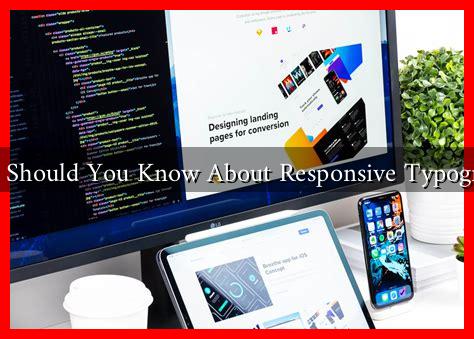-
Table of Contents
What Should You Know About Responsive Typography
In the digital age, where users access content across a myriad of devices, responsive typography has emerged as a crucial aspect of web design. It ensures that text is not only legible but also aesthetically pleasing, regardless of the screen size. This article delves into the essentials of responsive typography, its importance, techniques, and best practices.
Understanding Responsive Typography
Responsive typography refers to the practice of designing text that adapts seamlessly to different screen sizes and resolutions. Unlike traditional typography, which may rely on fixed sizes and layouts, responsive typography uses fluid measurements and scalable units to enhance readability and user experience.
Why Responsive Typography Matters
With the increasing use of mobile devices, responsive typography is more important than ever. Here are some compelling reasons why:
- Improved Readability: Text that adjusts to screen size ensures that users can read content without zooming in or straining their eyes.
- Enhanced User Experience: A well-structured typographic hierarchy guides users through content, making navigation intuitive.
- SEO Benefits: Search engines favor websites that provide a good user experience, which includes readable text across devices.
- Brand Consistency: Responsive typography helps maintain a consistent brand image across various platforms.
Key Techniques for Implementing Responsive Typography
To effectively implement responsive typography, designers can utilize several techniques:
- Fluid Typography: This approach uses relative units like percentages or viewport units (vw, vh) instead of fixed units (px). For example, setting a font size to 2vw means it will scale based on the viewport width.
- Media Queries: CSS media queries allow designers to apply different styles based on the device’s characteristics. For instance, you can set larger font sizes for desktop screens and smaller sizes for mobile devices.
- Modular Scale: A modular scale is a series of font sizes that are proportionally related. This technique helps maintain a harmonious typographic hierarchy across different screen sizes.
- Line Length and Height: Optimal line length (50-75 characters) and line height (1.5 times the font size) enhance readability. Adjust these parameters based on the screen size for better user experience.
Case Studies and Examples
Several companies have successfully implemented responsive typography, showcasing its effectiveness:
- Medium: The popular blogging platform uses fluid typography that adjusts seamlessly across devices, ensuring a consistent reading experience.
- Apple: Apple’s website employs a modular scale for its typography, creating a visually appealing hierarchy that guides users through their content.
- Smashing Magazine: This design publication uses media queries to adjust font sizes and line lengths, enhancing readability on both desktop and mobile devices.
Statistics Supporting Responsive Typography
Research indicates that responsive design, including typography, significantly impacts user engagement:
- According to a study by Google, 61% of users are unlikely to return to a mobile site they had trouble accessing.
- A report from Adobe found that 38% of users will stop engaging with a website if the content is unattractive, which includes poor typography.
Best Practices for Responsive Typography
To ensure effective implementation of responsive typography, consider the following best practices:
- Test across multiple devices and screen sizes to ensure readability.
- Utilize web-safe fonts or Google Fonts to maintain consistency across platforms.
- Keep accessibility in mind; ensure sufficient contrast between text and background colors.
- Regularly update and refine typography based on user feedback and analytics.
Conclusion
Responsive typography is an essential component of modern web design that enhances readability, user experience, and brand consistency. By employing techniques such as fluid typography, media queries, and modular scales, designers can create text that adapts beautifully to any device. As the digital landscape continues to evolve, prioritizing responsive typography will not only improve user engagement but also contribute to the overall success of a website. For more insights on web design, consider exploring resources like Smashing Magazine.


